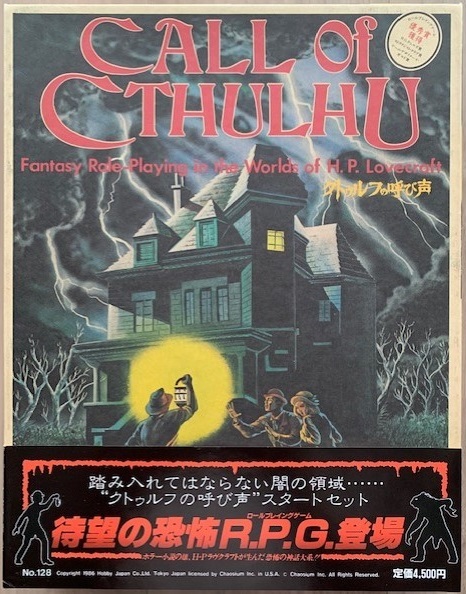Continuing with my discussion of Horror in Japanese Pop Culture, we move on to...wait. Did you just hear that? What was that? It sounded like...hmmm...probably just the wind.
Anyway, I'd like to discuss Horror Tabletop Gaming and its gripping hold on the Japanese market.
While the popularity of Tabletop RPGs has increased considerably in Japan over the last decade and especially in the the past two to three years, it is still a very small industry. It is considerably smaller than the relatively small market it is in the USA.
Here in the States, Dungeons and Dragons and Pathfinder have the lion's share of players/consumers, with the next closest game(s) pretty far behind. In Japan, Call of Cthulhu is currently the most popular tabletalk (more on that below) RPG. Yes, that Call of Cthulhu; the one created by Sandy Petersen and company and originally published by Chaosium Inc. in 1981.
The Japanese translated Call of Cthulhu RPG - specifically the game's 3rd Edition - landed in Japan in 1986, at first published by Hobby Japan and later taken over by Kadokawa, one of the largest publishing companies in Japan. It is largely developed for Kadokawa by Arclight, known for putting out TRPG, Card Games, Board Games, and Role & Roll Magazine (a monthly physical magazine dedicated to role playing and card games and my personal favorite such Japanese periodical).
This poster was made for a Call of Cthulhu 'live play'
video which featured Anime Voice Actors playing
the RPG in order to promote the game.
Call of Cthulhu and the Cthulhu Mythos caught the cultural imagination of the Japanese due largely to the Horror elements that appeal to them throughout the genre - body horror, loss of individuality and sense of self, the 'cosmic' / Science Fiction origins of the often kaiju-sized monsters - these things are all central to Call of Cthulhu.
Additionally, the Basic Role-Playing Game created by Greg Stafford and Lynn Willis and used for Call of Cthulhu turned out to be very well received by the tabletalk gaming fans of Japan. The system's use in emulating the 'real world', from the 1920s to modern times is especially valuable to its customers who seem to really enjoy gaming in such settings.
What I find particularly interesting is that today the popularity of CoC is so great that it has spawned (heh) a slew of new material unique to Japan. In addition to a variety of sourcebooks and adventures created by Arclight, a vast array of Doujinshi or fan produced, self-published works are made for Call of Cthulhu, many of which are not directly focused on or connected to the Lovercraftian stories themselves.
Therein lies the part that fascinates me the most but might surprise traditional fans of the game. The doujinshi I've seen run the gambit from tragic vampire romance to possessed serial killers to a mini-zombie apocalypse. Additionally, there are a ton of Cthulhu Replays.
As I've discussed before, though perhaps not thoroughly enough, the Japanese TRPG market is all about the Replays. These are recounts of gaming sessions, often accompanied by rules, Player and GM tips, or the like, in the form of Manga. The second cover above (left to right - top row) is for a Replay Manga entitled 'R'lyeh High School, a very Japanese style story about a High School that trains students to fight off Cthulhu.
My friend Ray, whom I game with quite regularly and who happens to be a big fan of Anime and Manga, noted that Japanese Horror tends to blur the lines of its sub-genres. This would explain why the fan made CoC scenarios and comics are so diverse. To the Japanese creators and their audience, nameless, faceless, monstrosities from beyond time and space are part of the Cthulhu Mythos but so are ghosts, mummies, and murderous madmen. It's all Horror and therefore it all works in the Call of Cthulhu game.
As with any successful endeavor there is bound to be competition and copycats. In the case of CoC, while no other Horror game matches it in popularity, others have made a name for themselves by either being similar but with some sort of twist or wholly unique.
Next up I will discuss some of those, particularly my favorites: Peekaboo Horror and inSane - two games utilizing the Dice Fiction rules system.
See you then...
AD
Barking Alien




I was surprised to see that CoC was one of the games translated in Japanese. thank to your post, I understand why.
ReplyDeleteMany horror movies and book are about people getting hideously killed by monster. With CoC the characters loose their sanity.
And (I'm over-simplifying) many Japanese are more afraid of loosing their place in the society than loosing their life. (Insanity is a good way to be shunned by others.)
By the way, last time I was in Japan, I saw a box of HarnMaster 3rd edition in Japanese. I don't know if the whole game was translated or just the box.
For RPG fans that travel to Japan, there is a Yellow Submarine Shop in Akihabara that sells TRPG.
Well I can add this to "things I didn't know". I would have guessed something like D&D, a Samurai type game, a Supers game maybe with Sentai type emphasis, or a cyberpunk game - CoC would not have been in my top 5.
ReplyDeleteThanks BA!